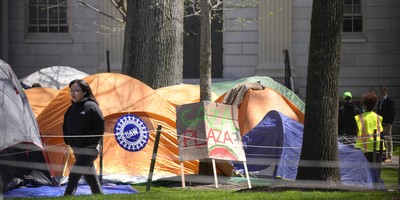Two fishermen walked into the woods…
We interrupt the annual joke column for a special announcement: For three years I’ve tried to relieve tax time depression and exhaustion by offering some humor, but this year a sad 70th anniversary trumps lightheartedness. I’ve put the jokes into two columns on Worldmag.com, so I have room here to address the question: Would you rather die in combat or in a concentration camp?
Facts: The 70th anniversary is of the Warsaw ghetto uprising, which began on April 19, 1943, and ended on May 16 amid smoke and fire. Background: Hitler’s minions beginning in 1940 had packed about 410,000 Jews into 1.3 square miles. The official ration was 184 calories per day for Jews and 2,613 for their German overlords. Nazi forces shipped 254,000 residents to the Treblinka “labor camp” and murdered them there. Warsaw starvation and disease killed close to 100,000 more.
Jewish leaders at first bought the lie that Treblinka was a place to work rather than to die, but by 1943 the truth was out. Many Warsaw residents decided to fight back even though the Germans had tanks, flamethrowers, and other modern conveniences, while the ghetto residents had six rifles and one submachine gun along with handguns and grenades, but not much ammunition.
German soldiers day after day drove the Jewish fighters from the streets and houses into sewers and bunkers, then used flamethrowers: About 13,000 Jews died in the uprising, probably half from smoke inhalation or being burnt alive. Marek Edelman, one of the few who survived—he became a noted cardiologist and died only four years ago at age 90—said, “There was no air, only black, choking smoke and heavy burning heat radiating from the red-hot walls.?…?We were beaten by the flames, not the Germans.”
The winners shipped most of the 50,000 survivors to Treblinka and other camps, where almost all died. Edelman later said, “We knew perfectly well that we had no chance of winning. We fought simply not to allow the Germans alone to pick the time and place of our deaths.” He said the death of those at Treblinka “was far more heroic. We didn’t know when we would take a bullet. They had to deal with certain death, stripped naked in a gas chamber or standing at the edge of a mass grave waiting for a bullet in the back of the head.?…?It was easier to die fighting than in a gas chamber.”
Recommended
Since I’m a Jewish Christian, I feel some personal involvement in this. My great-grandparents were probably among the Jews from the Ukrainian town of Olevsk forced to march to a ravine two miles away. (Olasky means “the man from Olevsk.”) Last fall I scurried along an overgrown road to where they died, and saw a small monument proclaiming in Russian, “German invaders killed 900 children, women, and elderly people.”
The Jews in Olevsk did not fight back. They were among the millions surprised to find neighbors helping Nazis. Even after Hitler took power in Germany in 1933, and even after Kristallnacht (“the night of broken glass”) in 1938, almost no one expected mass murder. On the latter day, as thugs with government backing broke the windows of 7,000 Jewish businesses and burned 1,000 synagogues throughout Germany and Austria, crowds did not shout, “Jews, die!” They shouted, “Jews, go to Palestine!” or “Go to America!”
Problem: The British government then in charge of Palestine was placating Arabs by allowing in only a small percentage of the Jews who could otherwise have found a haven. Problem: The United States, which had welcomed tired, poor, and huddled masses until 1924, had also slammed the door. Other countries were similar. As Chaim Weizmann, who would become Israel’s first president, put it, “The world seemed to be divided into two parts—those places where the Jews could not live and those where they could not enter.”
So German policy changed from killing a few Jews and expelling the rest to killing them all. My Jewish Ukrainian relatives were used to tornado-like pogroms that raced through their villages, destroying several lives and houses but leaving others untouched. They didn’t expect mass murder, and some thought German rule would be an improvement over Joseph Stalin’s brutal Communist regime. The machine guns surprised them.

























Join the conversation as a VIP Member